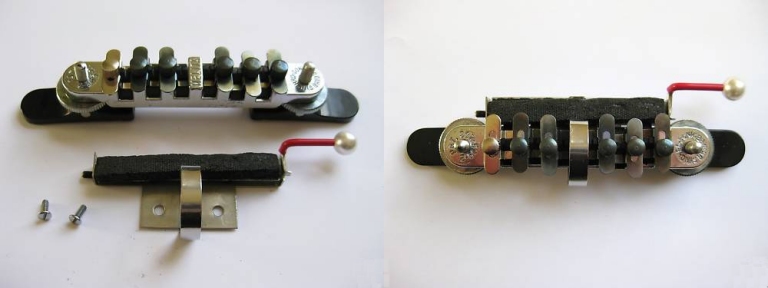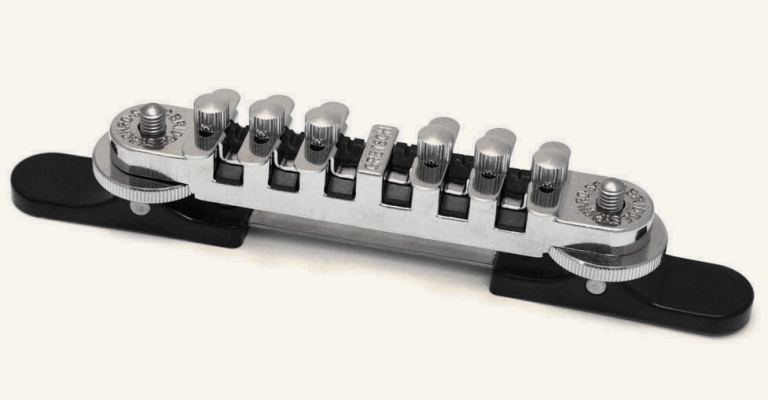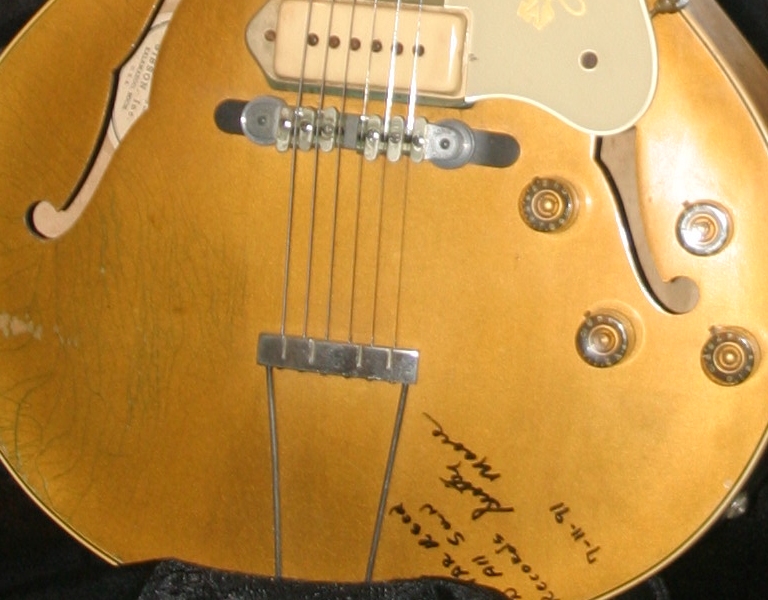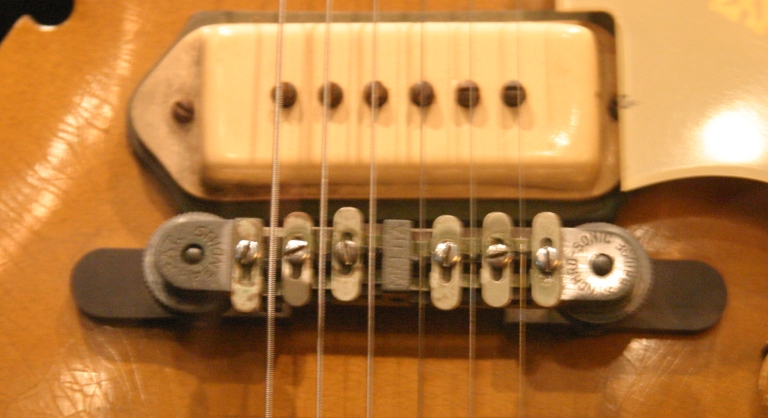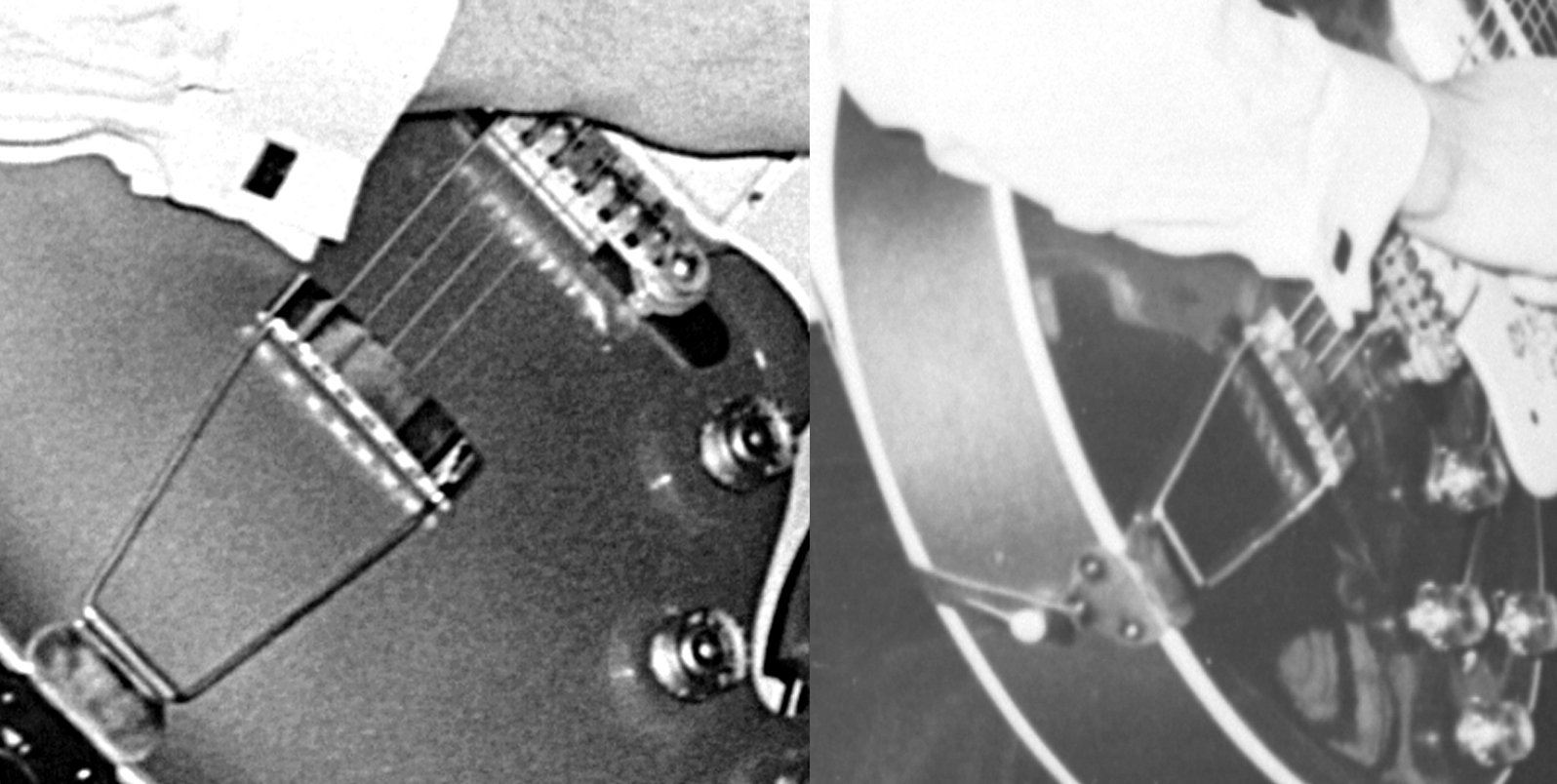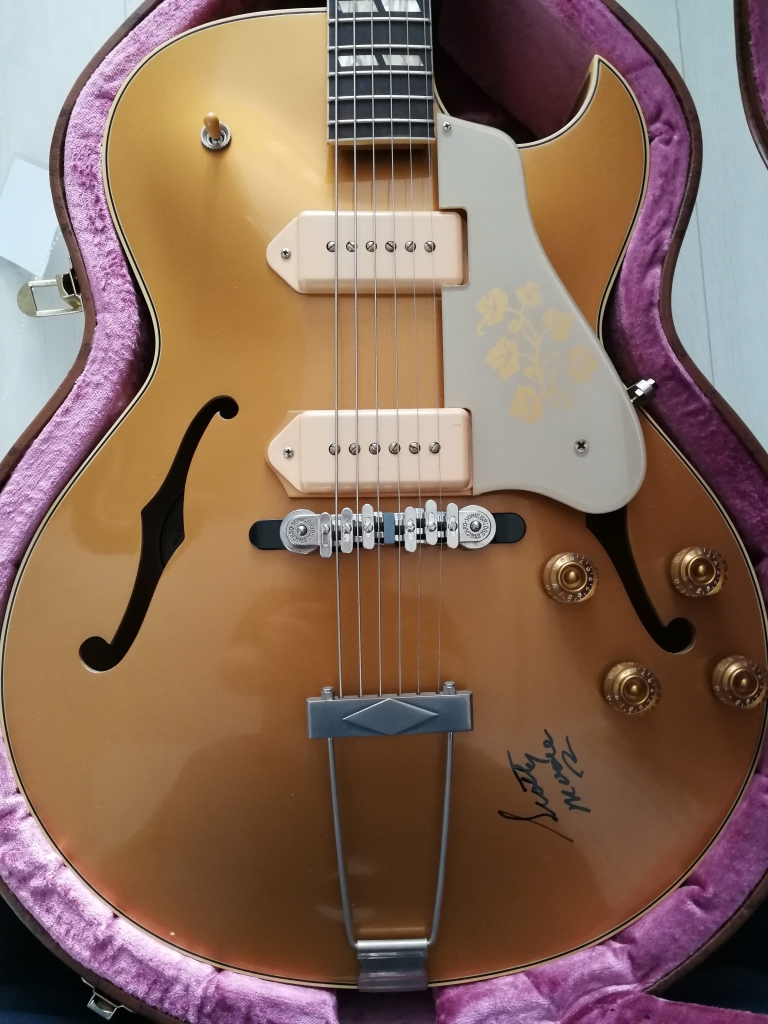 |
The Melita Synchro-Sonic Bridge
Scotty traded his Telecaster that he bought after leaving the Navy for a Gibson ES295 he saw in the window at Houck's in Memphis. His second wife Bobbie remembers him buying it after they were married in the summer of 1953, she said probably sometime in 1954. His ES295 was modified with an early "Melita Synchro-Sonic" bridge and a Kluson made trapeze tailpiece in place of the stock trapeze tailpiece/bridge introduced on the Les Pauls. It was never clarified if he actually made the modifications himself or if the guitar came that way, Bobbie didn't recall, and he never confirmed it when I asked him. The guitar however, shows that configuration when visible in all of the earliest pictures of him with it, both with the Starlite Wranglers and later with Elvis.
The Melita bridges were designed by Sebastiano (aka Johnny) Melita in Philadelphia, PA at least by the late 1940s. He applied for a patent in November of 1949. The patent number 2565253 was awarded in August of 1951, though according to the PennsylvaniaDB (Database), the Melita Products Company was incorporated on June 5, 1951. In all Melita would own six patents, four instrument related, one for a coffee maker and another 20 years earlier for a (baby) bottle support. Said to be located in the Washington Park district of Philadelphia, the company likely began production of the bridges prior to the awarding of the patent and it would be sometime before bridges with the number appeared on the market. By then they started using a heavier cast metal than the initial aluminum.
The Syncho-Sonic was the first, if not one of the first, bridges that allowed proper intonation. It accomplished that by allowing to move each of the saddles relative to the bridge to adjust the individual string lengths. It preceded Gibson's ABR-1 Tune-o-matic by several years. The early designs had wood bodies with no accounting for neck radius which would change by the time they started machining aluminum. Melita also experimented with plastic (Bakelite?). To lock the saddle clamps/clips and saddles (string rests) in place his design initially called for threaded studs that protruded through the slots from the body secured with knurled nuts.
The bridges seen in production though generally employed a simpler slotted screw until just before the patented bridges debuted and the slotted screws were replaced by thumb screws (low and/or tall profile). Some versions however came with low profile thumbscrews but were shorter lengths than subsequent versions. The "Pat. Pending" aluminum bridges were normally equipped with a floating base with Rosewood/Ebony pedestals/feet with two thumbwheels per pedestal to adjust elevation/string height and connected with an aluminum bar on pins to adapt to archtops. The upper wheel was used to set the height and the bottom wheel when tightened would serve to secure it in place. Some players opted to pin or screw the bases to the body to prohibit movement.
Melita was essentially an independent manufacturer basically offering the bridges through most stores and catalogs as an after market part. They were soon bought and used on guitars by several manufacturers and company's but most noticeably Gretsch who began offering them on models in both the polished aluminum and 24k gold plating. Trying to date them from the subtle changes is almost as difficult as dating older Fender guitars from parts.
Mat Wilson, of Embie Concepts, has been researching these bridges for some time. He said, as they got more popular, Sebastiano Melita cheapened his process and materials. He had trouble plating his cast aluminum bridge bodies, and some of them would sag under string tension. This is likely the reason he changed his method and materials. He was also under pressure to mass-produce the bridge once he got accounts with Gretsch and Kay. Gretsch would stock the Melita bridge, and they seemed to use it on many different models over the 1950's.*
Ed Ball, author of several books about Gretsch guitars, including Ball's Manual of Gretsch Guitars: 1950s said, the Gretsch guitar line first adopted the Melita bridge on the 1952 model year Electro II model 6192-3 (the precursor to the Country Club). The 1951 brochure of models does not mention the Melita as a feature. There was no '52 brochure produced. The 1953 brochure does not depict it on the 6193-2 illustration but Gretsch was using old art (to save money)... however, the text does confirm that by then, the Melita bridge was standard equipment. The bridges on these were the aluminum bodied, Patent Pending units.
Ed said, the Duo Jet models debuted in late 1953 and they received the Melita bridge from the beginning. Interesting enough the inaugural batch (150 guitars) was split, with half the group having a fixed (stud mounted) Melita bridge, while the other half of the batch got the more standard floating Melita style. I own two examples from the batch, one with the Fixed and the other with the Floating (bakelite body).
By July of 1954 Melita had redesigned the bases, now with plastic pedestals with a flexible metal band connecting them and a single thumb wheel elevator per post. This in theory more easily adapts to flat top guitars and any curvature of archtops as installation may require. These units began appearing on bridges about the time as the patent numbers on the cast metal bodies, though the patent for the new base design was not awarded until 1957.
For a short time at least, on models in 1954 and 1955 the cast bridge bodies bore the "MELITA" name in embossed/raised lettering, instead of the far more common, and final, sunken type of embossing (or debossed). Contrary to what some may believe, say or try to sell, no vintage Melita bridge from that era bore the brand "GRETSCH."
The slotted screws were no longer used to secure the saddle clamps, instead Melita used thumb screws. In theory that eliminated the need of looking for a small screw driver to make adjustments on the fly. Depending on playing style however, the thumb screws could be uncomfortable for some while playing and a hindrance when trying to mute strings. Many opted to substitute the thumb screws for the low profile slotted screws.
They seemed to inconsistently come with two versions of thumb screws too, tall and also low profile. Like the clamps they were made of brass and at times other metal but always plated. The cast bodies also did away with the recessed rectangular cutout on the bottom, no longer necessary with the thin flex band connecting the pedestals of the base. For a time also the base was made of one piece plastic eliminating the metal flex band. Though not uncommon to find today, they I'm told were not made for long.
The popularity of the bridges in general varies and like most things musicians either swore by them or swore at them. Guitarist Billy Zoom is one that swears by them. He puts them on all his guitars, except Stratocasters. He said that its not uncommon for players that use(d) them to swap out the thumb screws for the smaller lower slotted screws. That, too, is what he's done to all of his and has an ample supply in stainless steel he sells in sets, very reasonably, to any that want to do the same.
The Melita Products Co. continued making the bridges at least through the '60s. Some have said they've seen them offered in catalogs through the '80s. In 1968 Sebastiano Melita received a patent for a string mute, which attached to his bridge. Though the Penn. DB still lists the status of the company as active, no business exists there anymore and the patents are expired.
However, according to Ed, Gretsch applied Melita bridges as standard equipment until the 1958 model year, when they changed to their internally manufactured "Space-Control" bridge. Mat pointed out that, it was Jimmy Webster of Gretsch that decided to make more parts in-house, so they would save money per unit. He designed the "Space Control" bridge, which quickly took over. Although it did not intonate, the "Space Control" bridge meant that Gretsch didn't have to order their bridges in.* Ed noted that Melitas were still being manufactured, but Gretsch did not employ them any longer. The reissue Gretsch models, made since the Gretsch brand was resuscitated in the 1990's began using their own Synchro-Sonic bridges, basically "Gretsch" branded Melita reproductions.
Since 2011, Mat and Embie Concepts of St. Louis have been manufacturing Synchro-Sonic style bridges and parts which are a cross between the early Melita Patent Pending Aluminum design with slotted screws and the later patented plastic flex base. He says, the original cast aluminum Melita was a far nicer bridge, being light weight, very resonant, and smooth to the palm using flat pan-head screws. This was our inspiration for the Embie-Matic bridge assembly. We have tightened up the tolerances, and improved on the original design, machining our bridge body from aircraft aluminum, and anodizing instead of plating.*
Catering to the subjective tastes of musicians they also provide a choice of saddle material that includes: Bakelite, Delrin, Buffalo Horn, Cow Bone, aluminum, bronze and stainless steel to help get the sound desired. Bakelite, he said, is by far the most popular saddle material.*
Scotty's ES295 was/is equipped with the early Patent Pending aluminum Melita bridge with the wood base and double thumb wheel elevators. The one believed to be his has slotted screws instead of the thumb screws. Its not easily seen though in photos if they were on it when he owned it or if it had thumb screws. Considering the amount of time between him owning it and it surfacing as a collectible any number of changes may have occurred. That one has definitely been well played in those years and the tailpiece at least had been replaced.
The Kluson tailpiece was the type used on ES125s and other guitars of that era. The tailpiece now on the one believed to have belonged to Scotty appears to be of a design seen on some older National archtop guitars identical to ones made in Japan by Teisco and used on some Japanese models exported to the US and UK in the late '50s and '60s. They may have based that design on a Kluson available from Gibson on ES150s in the 1940s.
When Gibson did their run of signature tribute ES295s in 2013, they used the contemporary Gretsch Synchro-Sonic bridges but ground off the name and installed slotted screws on the saddle clamps. Since the '60s Japanese Teisco tailpieces like the one on the guitar believed to be Scotty's now are not so readily available, nor the original Kluson, Gibson used a style seen on many archtops for years, including their own ES335s. Special Thanks to Ed Ball, Billy Zoom, Mat Wilson and members of both The Gretsch Pages and The Beatgear Cavern forums for their input on this page. page added January 24, 2018
|
|
|
All photos on this site (that we didn't borrow) unless otherwise indicated are the property of either Scotty Moore or James V. Roy and unauthorized use or reproduction is prohibited. |
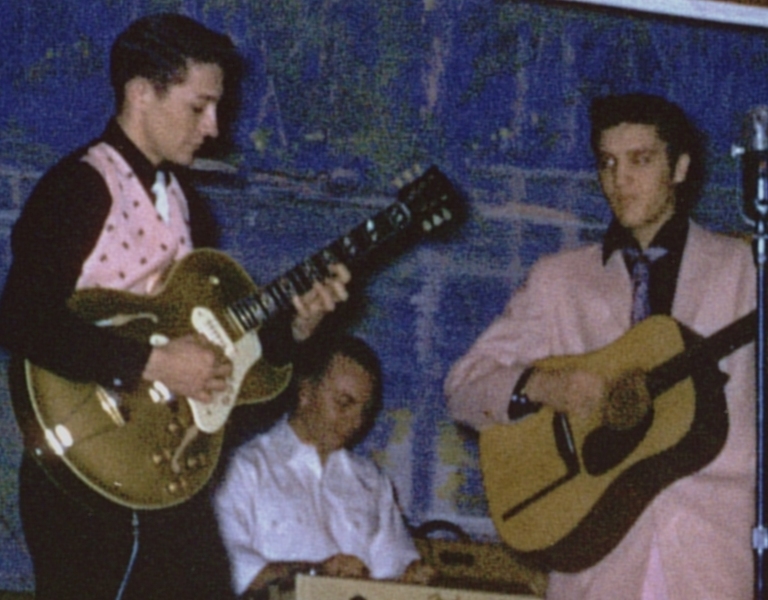
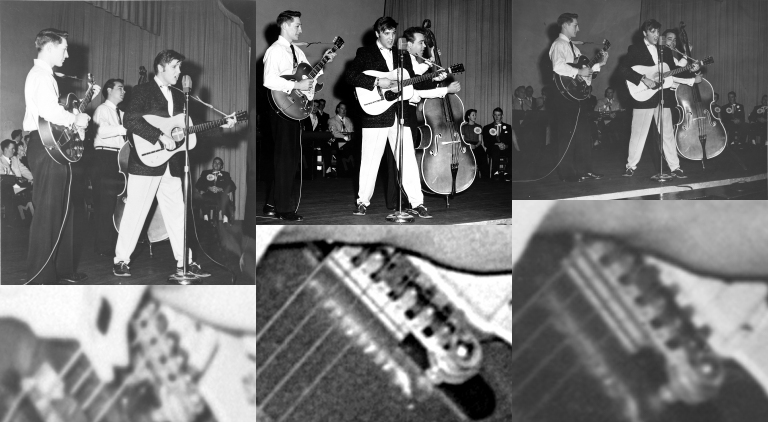
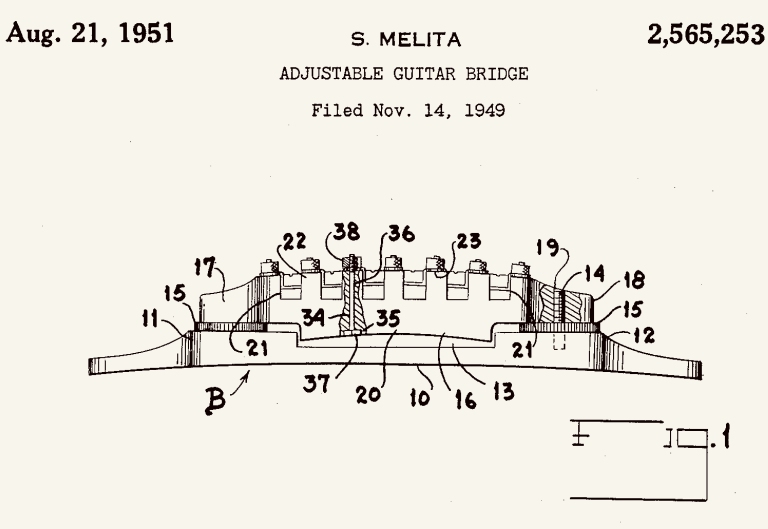

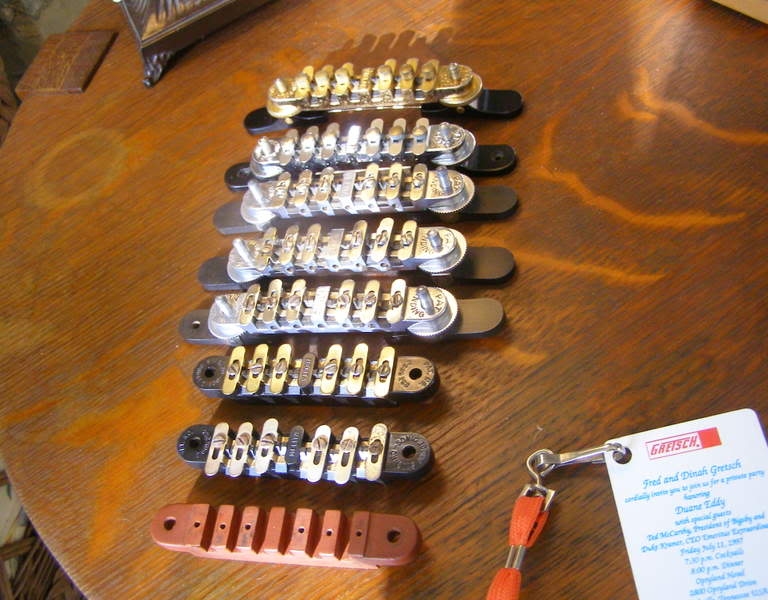
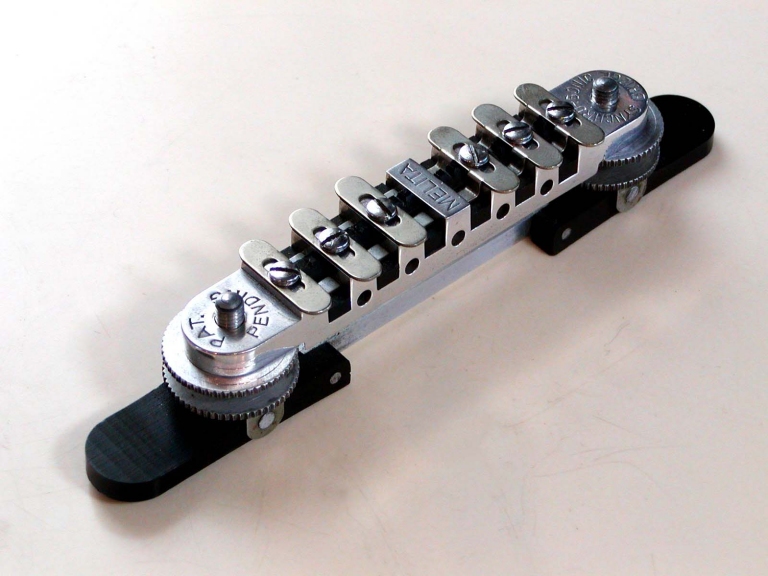
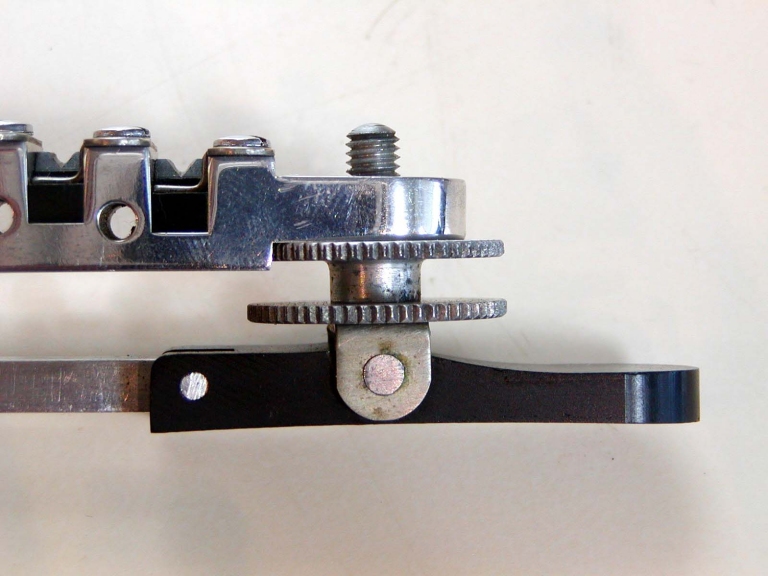
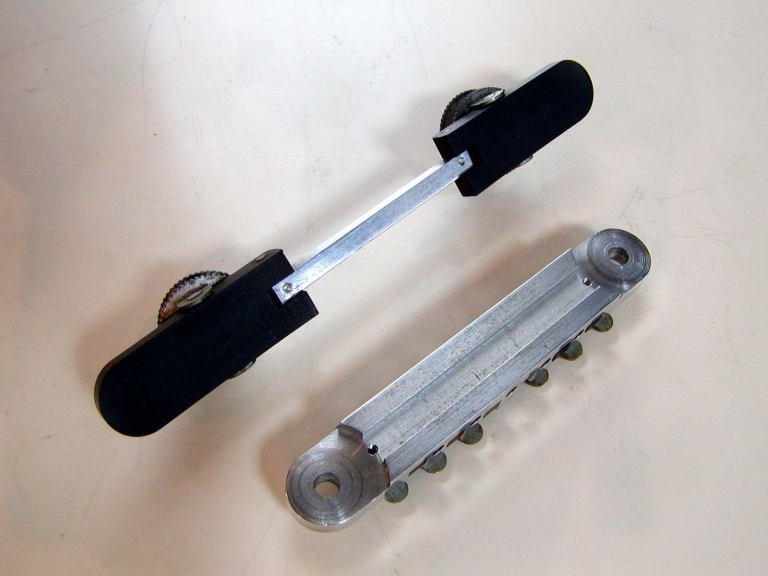
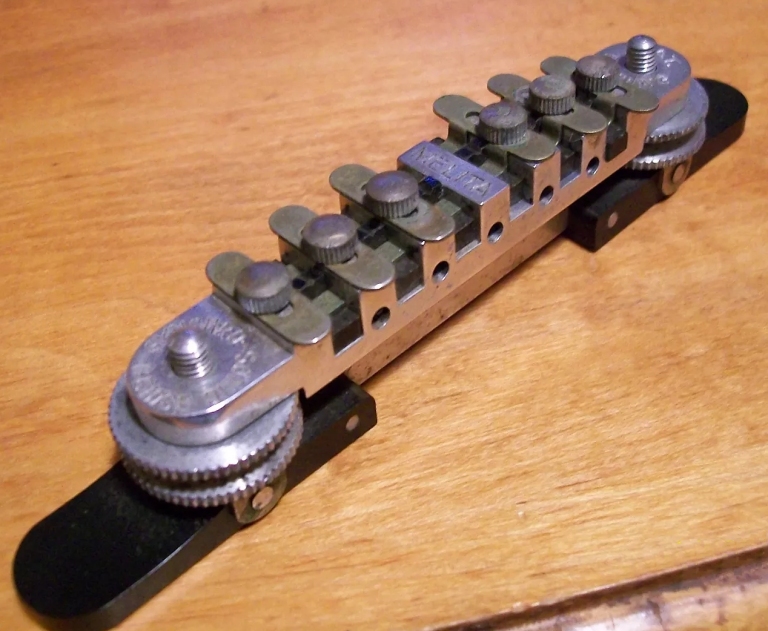
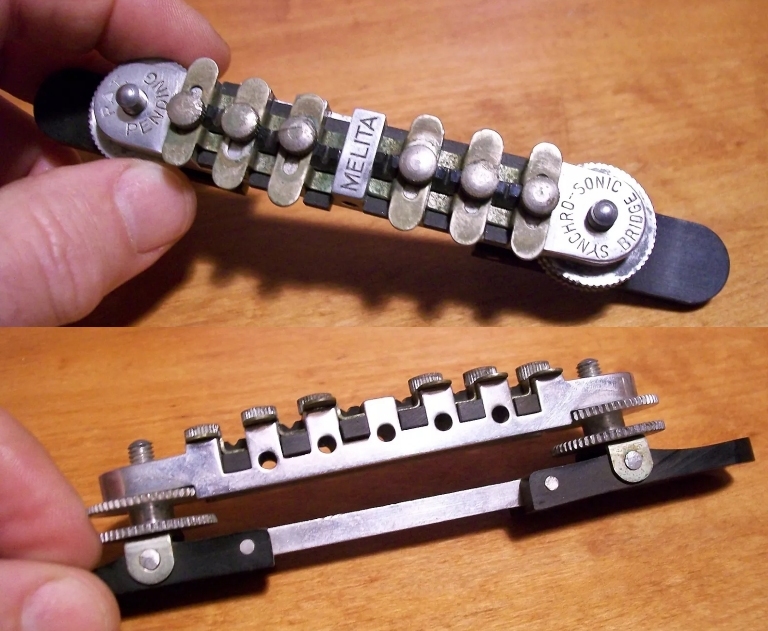
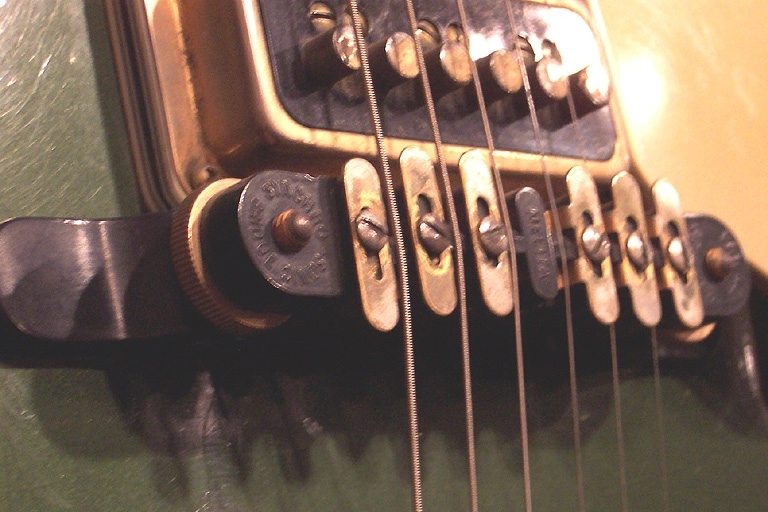
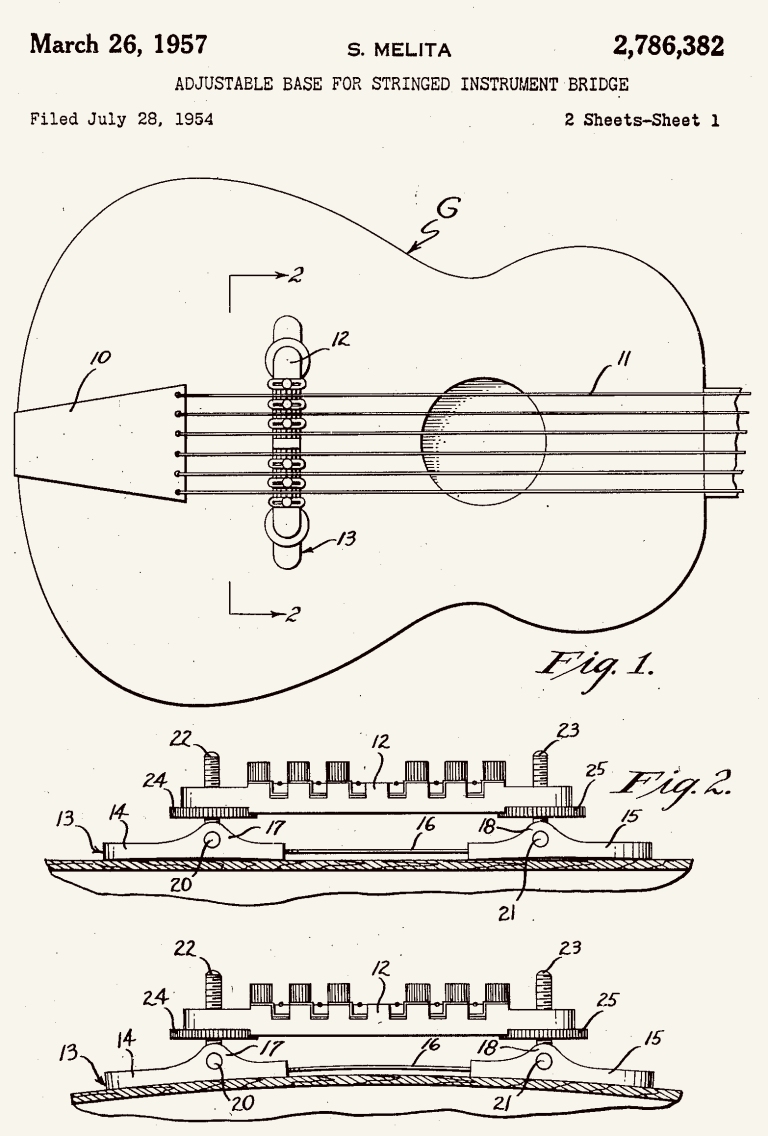
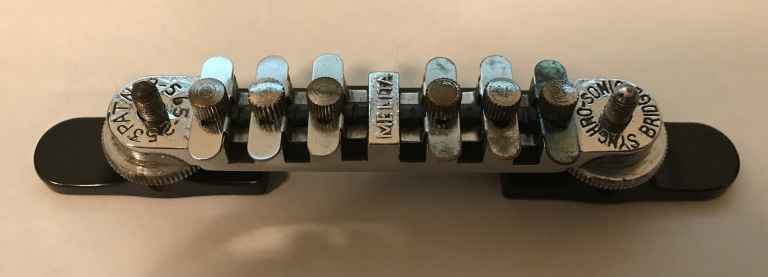


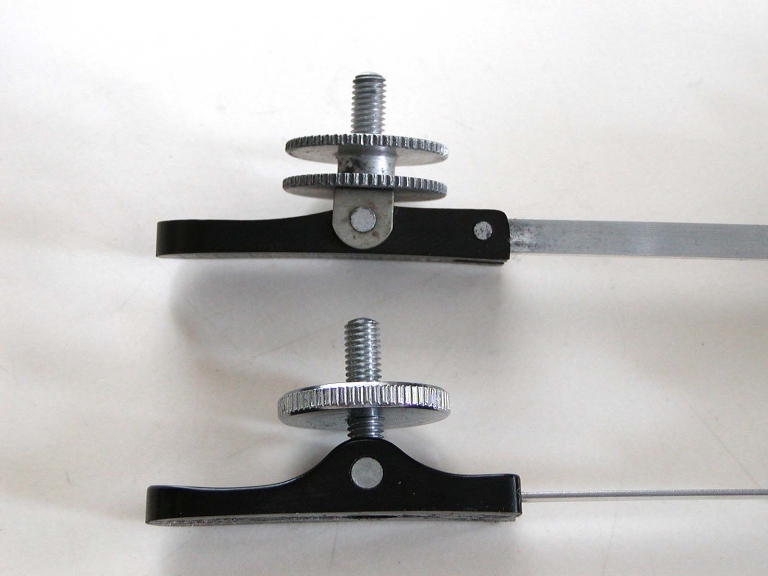
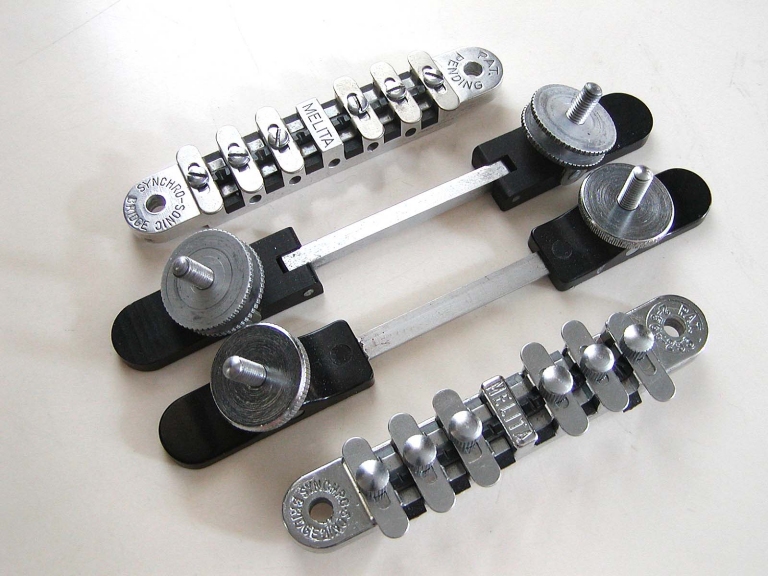
.jpg)


.jpg)
.jpg)
.jpg)

